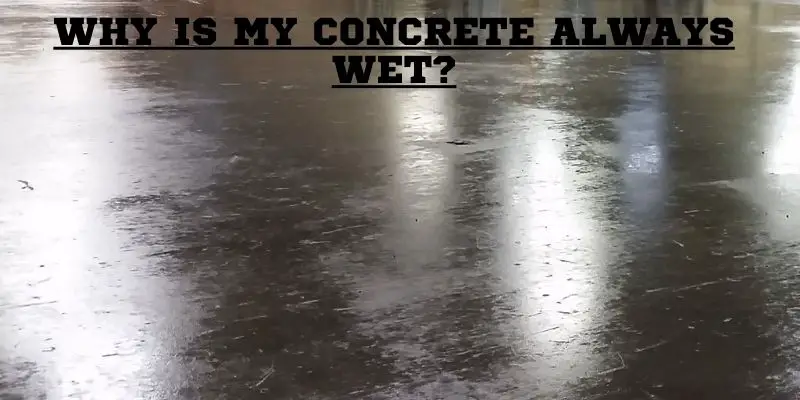Have you ever noticed that your concrete surfaces always seem to be wet, even on sunny days? This can be both frustrating and potentially dangerous, as wet concrete can be slippery and hazardous to walk on. But fear not! There are several reasons why your concrete may be staying wet, and even better, there are solutions to fix the issue. In this article, we’ll explore the top reasons why your concrete is always wet and provide you with practical tips and tricks to dry it out. From poor drainage to condensation, we’ll cover it all. So, whether you’re dealing with a wet driveway, patio, or basement floor, we’ve got you covered. By the end of this article, you’ll be equipped with the knowledge and tools to remedy the problem and enjoy dry, safe concrete surfaces once again.

Understanding the Problem: Why Is Your Concrete Always Wet?
Before we dive into the solutions for fixing wet concrete, it’s important to understand the problem at hand. There are several reasons why your concrete may be staying wet, and pinpointing the cause of the issue is the first step in finding a solution.
The Effects of Wet Concrete
Firstly, it’s important to understand the effects of wet concrete. Wet concrete can be slippery, making it dangerous to walk on. It can also lead to the growth of mold and mildew, which can cause health problems such as allergies and respiratory issues. Additionally, wet concrete can cause damage to the surface over time, leading to cracks and other structural issues.
Common Causes of Wet Concrete
So, what causes wet concrete? There are several potential culprits, including:
Poor Drainage
One of the most common causes of wet concrete is poor drainage. If your concrete surface is not sloped properly or if there is no drainage system in place, water can pool on the surface, leading to a perpetually wet surface.
Groundwater Seepage
Another potential cause of wet concrete is groundwater seepage. If the water table in your area is high or if there are underground springs, water can seep up through the ground and saturate your concrete surface.
Condensation
In some cases, the moisture on your concrete surface may actually be condensation. This can happen when warm, moist air comes into contact with a cold concrete surface, causing moisture to collect on the surface.
Poor Ventilation
Finally, poor ventilation can also contribute to wet concrete. If the area underneath your concrete surface is poorly ventilated, moisture can become trapped, leading to a perpetually wet surface.
Solutions for Fixing Wet Concrete
Now that we’ve identified some of the potential causes of wet concrete, let’s explore some solutions for fixing the issue.
Tools and Equipment Needed for Fixing Wet Concrete
Before we dive into the solutions, it’s important to make sure you have the right tools and equipment for the job. Here are some items you may need:
– A pressure washer or hose
– A wet/dry vacuum
– A sump pump
– A dehumidifier
– Concrete sealant
Step-by-Step Guide to Fixing Wet Concrete
Step 1: Identify the Cause
The first step in fixing wet concrete is to identify the cause of the issue. Is it poor drainage? Groundwater seepage? Condensation? Poor ventilation? Once you’ve identified the cause, you can move on to finding a solution.
Step 2: Remove the Water
Once you’ve identified the cause of the issue, the next step is to remove any standing water from the surface. Depending on the amount of water, you may need to use a pressure washer or hose to remove the water, or you may need to use a wet/dry vacuum or sump pump to remove larger amounts of water.
Step 3: Dry the Surface
Once the standing water has been removed, it’s important to dry the surface thoroughly. You can use a dehumidifier to remove excess moisture from the air, and a fan to help circulate the air and speed up the drying process.
Step 4: Seal the Surface
Finally, once the surface is dry, you can apply a concrete sealant to help prevent moisture from penetrating the surface in the future. Be sure to follow the manufacturer’s instructions for applying the sealant.
Preventive Measures for Keeping Concrete Dry
Of course, the best way to deal with wet concrete is to prevent it from happening in the first place. Here are some preventive measures you can take to keep your concrete surfaces dry:
– Ensure proper drainage by sloping the surface or installing a drainage system
– Install a vapor barrier to prevent groundwater seepage
– Improve ventilation in the area underneath the concrete surface
– Apply a concrete sealant regularly to help prevent moisture penetration
When to Call a Professional for Help
In some cases, fixing wet concrete may require the help of a professional. If you’re dealing with a particularly large or complex issue, or if you’re not comfortable tackling the job yourself, it’s best to call in a professional contractor who can help identify the cause of the issue and provide a solution.
Conclusion
Wet concrete can be a frustrating and potentially dangerous issue to deal with, but thankfully there are solutions available. By identifying the cause of the issue and taking steps to remove standing water, dry the surface, and prevent moisture penetration in the future, you can enjoy dry, safe concrete surfaces once again. Whether you choose to tackle the job yourself or call in a professional, the key is to take action as soon as possible to prevent further damage and ensure the safety of those using the surface.
